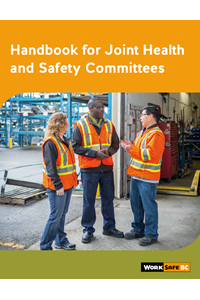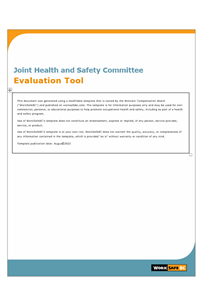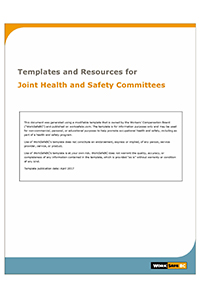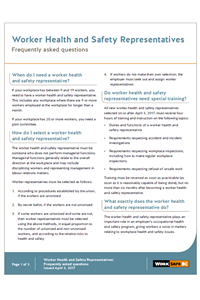Joint health & safety committees
The joint health and safety committee supports the employer's duty to ensure a healthy and safe workplace. The joint committee brings together representatives of the employer and the workers, to identify and help resolve health and safety issues in the workplace.
- When you need a joint health and safety committee
- When you need a worker health and safety representative
- What joint committees and worker health and safety representatives do
- Mandatory training and annual education leave
- Evaluation of joint committees
- Resources
When you need a joint health and safety committee
If your workplace has 20 or more workers, you need a joint committee. This includes any workplace where there are 20 or more workers employed at the workplace for longer than a month. WorkSafeBC may also order that a joint committee be established in any other workplace.
When you need a worker health and safety representative
If your workplace has more than 9 but fewer than 20 workers, you need to have a worker health and safety representative. This includes any workplace where there are 10 or more workers employed at the workplace for longer than a month.
What joint committees and worker health and safety representatives do
The joint committee plays an important role in your occupational health and safety program, giving workers and employers a way to work together to identify and find solutions to workplace health and safety issues. The joint committee has the following specific duties and functions:
- Identify situations that may be unhealthy or unsafe for workers, and advise on effective systems for responding to those situations
- Consider, and promptly deal with complaints relating to the health and safety of workers
- Consult with workers and the employer on issues related to occupational health and safety, and the occupational environment
- Make recommendations to the employer and the workers for the improvement of the occupational health and safety, and the occupational environment of workers
- Make recommendations to the employer on educational programs promoting the health and safety of workers and compliance with the OHS provisions of the Workers Compensation Act and the regulations, and to monitor their effectiveness
- Advise the employer on programs and policies required under the regulations for the workplace, and to monitor their effectiveness
- Advise the employer on proposed changes to the workplace, including significant proposed changes to equipment and machinery, or the work processes that may affect the health or safety of workers
- Ensure that incident investigations and regular inspections are carried out as required
- Participate in inspections, investigations and inquiries as provided in the OHS provisions of the Workers Compensation Act and Part 3 of the Regulation
In workplaces where a worker health and safety representative is required, the representative has the same duties and functions as a joint committee, to the extent practicable.
Mandatory training and annual education leave
Mandatory training
The requirements for mandatory training are different for joint committee members and worker health and safety representatives.
All joint committee members selected on or after April 3, 2017 must receive eight hours of training and instruction.
All worker health and safety representatives selected on or after April 3, 2017 must receive four hours of training.
See Joint committee member and worker health and safety representative training for more information.
Annual education leave
All joint health and safety committee members and worker health and safety representatives are entitled to eight hours of leave per year to attend occupational health and safety training. For information on courses near you, contact local OHS training providers. OHS courses are considered acceptable if the employer follows a reasonable process of assessing the training needs of committee members and selects appropriate training programs.
Evaluation of joint committees
Section 3.26 of the Regulation requires a written evaluation to be conducted annually to determine the effectiveness of the joint committee. The intent of the evaluation is to determine whether the joint committee is in compliance with the Act and Regulation, and to assess whether the joint committee has been effective in fulfilling its role. Evaluations should also identify improvements to be considered and implemented.
To assist in the evaluation process, committees can use the Joint Health and Safety Committee Evaluation Tool. You are not required to use this template, however, and can use your own committee evaluation tool as long as it includes all the information required by section 3.26 of the Regulation.




